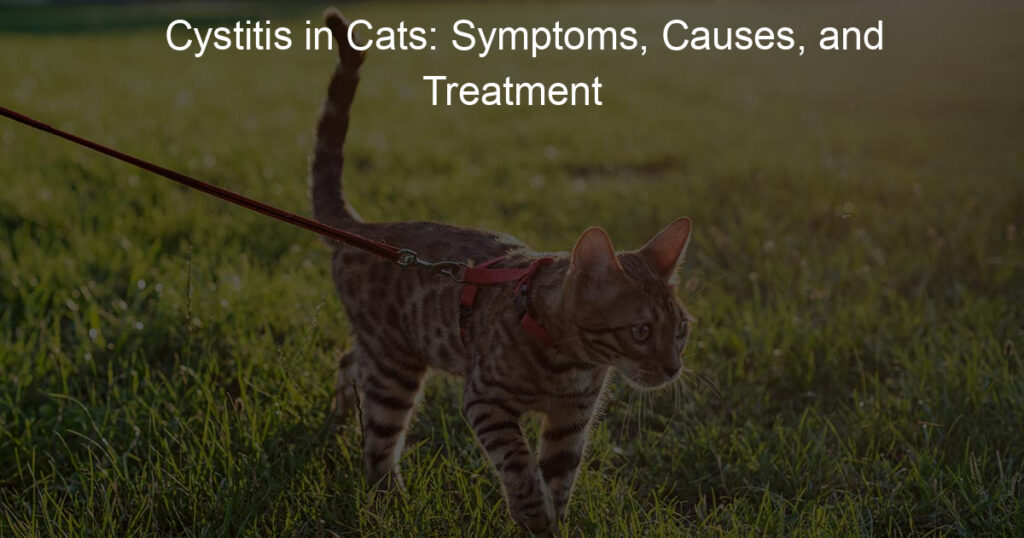Cystitis in cats can be an uncomfortable and painful condition that causes inflammation of the bladder. In extreme cases, they might even experience bleeding while urinating. Unfortunately, this is not a rare occurrence, as it affects around 25% of all cats at some point in their life.
If you are concerned your cat might have cystitis, then reading this blog post will provide invaluable insight into what cystitis is, what its symptoms are, what its possible causes are, and most importantly – how to treat this uncomfortable affliction in cats!
What causes cystitis in cats?
Cystitis, bladder inflammation, is a common issue among cats. One of the most frequent causes is a bacterial infection that leads to irritation of the bladder wall. Further, it is thought that underlying medical conditions can potentially trigger episodes of cystitis in cats. Stress and poor diet can also be contributing factors, as their immune systems are compromised and lead to further confusion and problems within their urinary tract.
Though not always easily treatable, understanding what may have contributed to cystitis in cats is key to preventing future cases from occurring.
What is the best treatment for cat cystitis?
The best treatment for cat cystitis depends on the underlying cause. Your veterinarian may prescribe antibiotics and anti-inflammatory drugs if the problem is due to a bacterial infection.
If your cat has kidney stones, she may be put on a special diet to help reduce the risk of later complications from crystal formation in their urine. If there is an obstruction present (ureteral blockage or bladder stone for example), your pet may need surgery to make sure the blockage does not recur. In mild or first-time bouts of cystitis, your vet may recommend that your cat will drink plenty of fluids and eat foods with increased water content as it helps flush out irritating toxins in the bladder. Herbal and homeopathic remedies also can offer comfort and reduce inflammation but should never replace any medical advice received from your veterinarian.
How long does cystitis last in cats?
Cystitis, or inflammation of the bladder, can be a painful condition for cats. Typically cystitis lasts anywhere from 3-10 days but can recur; given the complexity of the condition and its symptoms, it is best to take your cat to the veterinarian for an examination so that an initial diagnosis and potential treatment plan can be determined.
Depending on what caused the infection in the first place (stress, diet, etc.), further tests may need to be done to uncover potential underlying factors that may cause cystitis to come back. An experienced veterinarian will help you identify and address these issues before treating your cat with medications which can range from antibiotics or anti-inflammatory drugs if needed.
Do antibiotics help cystitis in cats?
Cystitis, or inflammation of the bladder wall, is a frequent issue in cats and can be very painful. Antibiotics are an effective treatment that can help cats with cystitis feel comfortable again. While antibiotics have been used to treat cystitis in cats for years, it is important to note that they might not always be necessary.
Some cases of cystitis can resolve themselves without treatment. If a cat is displaying signs of cystitis, such as frequent attempts to urinate, blood in the urine, or general discomfort, a veterinarian should be consulted for an accurate diagnosis and recommended course of treatment to ensure the best outcome for your pet.
Is cystitis chronic in cats?
Cystitis, a condition characterized by inflammation of the bladder, can be chronic in cats, leading to deteriorating health over time if left untreated.
In cats, recurrent urinary tract infections (UTIs) are usually caused by bacterial agents. When left unchecked, these infections can cause long-term damage to the lining of the bladder and result in cystitis becoming chronic. Thus cat owners need to pay attention to their pet’s urinating habits, as abnormal ones may indicate underlying issues that need prompt veterinary care. With appropriate treatments, most cats with cystitis will recover quickly and will not suffer from a recurring form of the disease.
The Bottomline: Cystitis in Cats: Symptoms, Causes, and Treatment
All in all, although cystitis can be a very big problem for cats, is treatable. It is important to take your cat to the vet if you see any symptoms of cystitis such as frequent urination, blood in the urine, or crying while using the litter box. It’s important to note that even with treatment, there may be relapses, so it’s good to know what to look out for.
If you notice any changes in litterbox usage from your cat, be sure to consult a veterinarian immediately so the proper diagnosis and treatment can be given. Following some simple dietary changes and giving plenty of water can also help keep your pet healthy and free from cystitis. It’s incredibly important that caretakers follow the veterinarian’s advice for optimal outcomes when dealing with cystitis in cats!












